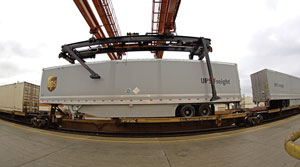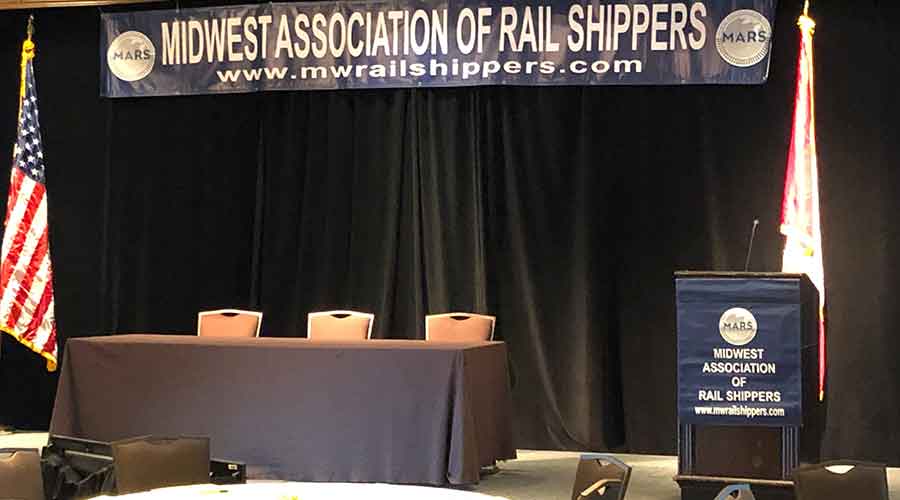Stay updated on news, articles and information for the rail industry
July 2014
Rail News: Shippers
Mines, utilities bolster rail infrastructure to keep power plants fueled
— by Jeff Stagl, Managing Editor
Railroads have transported the lion's share of coal around the nation for more than 100 years, and figure to continue doing so for decades to come. Today, rail still ranks as the dominant mode to move coal from mines to power-generation plants.
In 2013, power plants consumed 858 million tons of coal — accounting for 93 percent of all coal consumed in the United States — and two-thirds of it was transported either completely or in part by rail, according to a U.S. Energy Information Administration (EIA) news brief issued on June 11.
Electric utilities determine their primary transportation mode based on a power plant's location and access to a rail system, EIA officials said. Rail's market-share dominance hasn't changed in recent years, only fluctuating slightly at times due to changes in utilities' coal demand, for two main reasons. First, the United States is covered by an extensive rail network; and second, coal is produced in just a few parts of the country — predominantly in the Powder River and Illinois basins, and in Central and Northern Appalachia — but consumed by power plants in 46 of the 48 contiguous states, EIA officials said.
The U.S. Environmental Protection Agency's recently unveiled "Clean Power Plan" to reduce power plants' carbon emissions notwithstanding, more coal might move by rail in the not-too-distant future. An aging lock system could impact one of the nation's major river systems, prompting utilities to divert barge shipments.
But mining companies and utilities won't be eager to use railroads more extensively if it takes a long time to load coal at mines, transport it hundreds or thousands of miles by rail, and then unload it at power plants. Although each mine differs by terrain and each power plant differs by design or consumption needs, a seamless transportation system is needed to ensure coal gets from an origin to destination as quickly as possible, miners and utilities say.
"The goal is to gain as much speed and efficiency as possible in the supply chain," says Betsy Monseu, chief executive officer of the American Coal Council, a coal industry advocacy group that counts mining companies and utilities among its 165 members.
Railroads' speed and efficiency have been tested of late because the extremely cold winter and utilities' historically low stockpile levels caused an unexpected uptick in coal demand earlier this year that pressured the entire supply chain, she says. Railroads didn't have enough assets in place and remain in a catch-up period, Monseu adds.
"We think this uptick will extend to the end of the year and into 2015," she says.
Despite any fluctuations in demand, mining companies and utilities need to ensure they have the optimal rail infrastructure to accommodate coal consumption needs, from lead tracks to storage tracks to load-out or unloading facilities to sidings. Some miners now are trying to fulfill their future rail infrastructure needs when constructing track, such as by building track that can accommodate 150-car unit trains even though unit trains now typically range from 120 to 130 cars. And some utilities are aiming to better maintain or upgrade rail infrastructure at their aging power plants.
For Luminant Corp., keeping rail infrastructure in tip-top condition at both ends of the coal transportation supply chain is key. The company operates nine coal mines and four coal-fired power plants in east and central Texas that receive lignite coal via rail. In total, the utility manages 146 miles of track.
The four power plants typically are located five to 10 miles from a lignite mine. The Big Brown plant uses lignite coal from the company's Big Brown and Turlington mines, and supplements its fuel needs with Powder River Basin (PRB) coal; the Martin Lake plant uses lignite coal from the Beckville, Oak Hill and Tatum mines, and supplements with PRB coal; the Monticello Plant uses lignite coal from the Thermo and Winfield mines, and supplements with PRB coal; and the Oak Grove Plant uses lignite coal from the Kosse mine.
Luminant — which began mining lignite coal more than 40 years ago to fuel its first power plant near Fairfield, Texas — also uses it own railroad to fulfill its transportation needs. The Luminant Railroad employs 115 people, and uses 20 locomotives and more than 4,200 rail cars to deliver lignite and western-mined coal every day to the Big Brown, Martin Lake, Monticello and Oak Grove plants.
In 2013, Luminant Railroad hauled 149.8 million ton-miles of lignite and western coal. If the railroad was a short line, it would be one of Texas' largest, according to Luminant.
The company is focused on maintenance to ensure optimal track conditions, says Del McCabe, Luminant's northern region mine director.
Luminant employees inspect all track at least once per week and contractors typically perform the maintenance work 24/7, he says. In addition, Luminant contracts firms to inspect its rail bridges once per year.
"In spring and fall, we do the heavy track maintenance," says McCabe. "If there's cold weather, we might have a track section bust out, and then we need to get contractor out immediately to fix it quickly."
Luminant's rail system is heavily used — it's not unusual at the Martin Lake plant for the company's 19-car unit train to operate 24 times in a 24-hour period, he says. At the Oak Grove plant, Luminant Railroad operates two sets of 45-car unit trains 12 to 15 times per day.
"We control our own destiny and don't rely on someone else — we control coal movements from one end to the other," says McCabe.
At the three plants that supplement consumption with PRB coal, one to two unit trains operated by other railroads arrive at the plants daily.
Interchanges with another railroad were a primary consideration in 2008, when Luminant last constructed new rail infrastructure. The company built a 1.5-mile western coal siding at the Martin Lake plant to improve an interchange with BNSF Railway Co. and boost PRB deliveries.
American Electric Power (AEP) also counts Class Is among the six railroads that deliver coal to about 15 of its plants. The utility manages more than 100 miles of track at its facilities, including eight miles of track built at its John W. Turk Jr. plant in Fulton, Ark., that opened in December 2012.
Since AEP doesn't build rail infrastructure very often, track maintenance — which varies from plant to plant — is top of mind, says John Hume, AEP's principal tech specialist-engineering. The company typically hires outside firms to perform rail inspections while plants handle any maintenance work.
AEP performs studies to determine if there are better ways to build and maintain certain rail infrastructure, such as a spur, says Hume.
For the past 10 years, the utility also has used railroads and its rail infrastructure to take delivery of lime and limestone at plants for scrubbing and emission controls work. Although the lime and limestone arrives daily, or weekly in some cases, the volumes don't come anywhere close to coal volumes, says Hume.
AEP has developed quite a bit of rail expertise over the years because the plants in service today have been served by railroads since the 1940s, he says. The utility's overall rail proficiency dates back even further, Hume adds.
We Energies, which provides electric service to customers in portions of Wisconsin and Michigan's Upper Peninsula, also has developed rail expertise over a prolonged period. The utility has worked with railroads for decades at two of its power plants, says John Oswald, We Energies' coordinator of unit train operations.
Norfolk Southern Railway transports coal from eastern mines to Chicago, where Union Pacific Railroad then completes the move to the company's Oak Creek, Wis., generating complex. Each week, seven to nine 130- or 142-car unit trains serve the plant, which also takes delivery of some western coal via UP. At a Pleasant Prairie, Wis., plant, CN and UP deliver coal from PRB mines via five to seven 137-car unit trains per week.
We Energies concentrates on ongoing track maintenance at the two plants, such as keeping switches in good shape, says Oswald. The company also contracts track inspectors on an annual basis to help ensure rail remains in top condition.
Some of that rail was constructed at the Oak Creek plant in 2008, when We Energies added two power-generating units to increase capacity. The utility needed to increase coal deliveries at the plant to fuel the new units, says Oswald.
The company constructed 17 miles of track, including two loop tracks designed to accommodate 150-car unit trains. We Energies focused on the rail infrastructure within the Oak Creek complex while UP worked on the rail leading into the plant, says Oswald, adding that the railroad also improved other track and built a siding.
"All the work improved throughput at the plant, and cycle times improved," says Oswald.
Now, We Energies officials are deciding whether to make rail improvements at the Pleasant Prairie plant. Construction on a track that would be used to maintain rail cars might begin in a year or so, says Oswald.


 2025 MOW Spending Report: Passenger-rail programs
2025 MOW Spending Report: Passenger-rail programs
 Gardner steps down as Amtrak CEO
Gardner steps down as Amtrak CEO
 Guest comment: Oliver Wyman’s David Hunt
Guest comment: Oliver Wyman’s David Hunt
 Women of Influence in Rail eBook
Women of Influence in Rail eBook
 railPrime
railPrime






